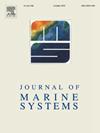30 years of sea surface temperature and salinity observations crossing the Southern Ocean near 140°E: Trends and rollercoaster variability
IF 2.7
3区 地球科学
Q2 GEOSCIENCES, MULTIDISCIPLINARY
引用次数: 0
Abstract
Observations of high-resolution sea surface temperature, salinity and density are analysed over 30 years along a transect crossing the Southern Ocean from Tasmania to Antarctica near 140°E during austral summer. Three dynamical regions are investigated in fixed latitude bands. The Subtropical and Subantarctic Zones show a surface warming trend of 0.33 °C/decade in accord with previous studies, and surface salinity has increased by 0.05/decade. This trend towards warmer, saltier surface waters is mostly density compensated; the large trend dominates over the interannual variability. The increased presence of warm, salty subtropical waters is linked to the poleward shift in the Subtropical Front which is now located 160 km further south than in the early 1990s, whereas the Subantarctic Front and Polar Front positions remain stable. This reduces the effective summer surface area of the Subantarctic Zone by one-third over 30 years. Interannual changes in the influx of subtropical waters across 140°E are linked to the main climate modes. Austral summers having warmer, saltier conditions occur during the positive Southern Annular Mode (SAM) and La Nina phases; cooler fresher conditions occur during negative SAM and El Nino. In the Antarctic Zone south of the Polar Front, the freshening trend reported over the 1990s and 2000s has stabilized. The mean austral SSS increased slightly over the last decade, and the 30-year trend in surface salinity is now zero. The Sea-Ice Zone south of 60°S around 140°E was largely impacted by the Mertz Glacier calving in 2010, releasing a large volume of sea-ice over the following years. Interannual changes in summer surface salinity are anti-correlated with the available sea-ice the previous spring. Over the 30-year period, the region south of 60°S has freshened by 0.012 per decade, and cooled by 0.06 °C per decade. Coastal waters off Antarctica show the largest impact: here surface waters have freshened by 0.1 over three decades, even as the summer sea-ice concentration has been reduced by 2.5 %. The Subantarctic Zone and the Sea-Ice Zone exhibit a rollercoaster of large interannual changes since 2017, and continued monitoring is required to understand the long-term effects of this recent increased variability.
东经140°附近穿越南大洋的30年海表温度和盐度观测:趋势和过山车式的变化
在南极夏季,沿着从塔斯马尼亚到南极洲的横断面,分析了30年来在东经140°附近的高分辨率海面温度、盐度和密度观测。在固定纬度波段研究了三个动力区域。与以往研究结果一致,副热带和亚南极区地表增温趋势为0.33°C/ a,地表盐度增加0.05°C/ a。这种变暖、变咸的地表水趋势主要是密度补偿的;大趋势大于年际变率。亚热带温暖咸水的增加与副热带锋的极向移动有关,副热带锋现在比1990年代初向南移动了160公里,而亚南极锋和极锋的位置保持稳定。这使得亚南极区的夏季有效表面积在30年内减少了三分之一。140°E副热带海水流入的年际变化与主要气候模式有关。在正的南环模(SAM)和拉尼娜阶段,南方夏季的温度更高、更咸;在负SAM和厄尔尼诺期间,天气会变冷。在极地锋以南的南极区,1990年代和2000年代报告的新鲜趋势已经稳定下来。在过去十年中,平均南部SSS略有增加,表面盐度的30年趋势现在为零。60°S以南约140°E的海冰区在很大程度上受到2010年默茨冰川崩解的影响,在接下来的几年里释放了大量的海冰。夏季海面盐度的年际变化与前一个春季可用海冰呈反相关关系。30年间,60°S以南地区每10年升温0.012°C,每10年降温0.06°C。南极洲沿海水域受到的影响最大:在过去30年里,这里的地表水变新鲜了0.1%,而夏季海冰浓度却减少了2.5%。自2017年以来,亚南极带和海冰带呈现出巨大的年际变化,需要持续监测以了解最近这种变动性增加的长期影响。
本文章由计算机程序翻译,如有差异,请以英文原文为准。
求助全文
约1分钟内获得全文
求助全文
来源期刊

Journal of Marine Systems
地学-地球科学综合
CiteScore
6.20
自引率
3.60%
发文量
81
审稿时长
6 months
期刊介绍:
The Journal of Marine Systems provides a medium for interdisciplinary exchange between physical, chemical and biological oceanographers and marine geologists. The journal welcomes original research papers and review articles. Preference will be given to interdisciplinary approaches to marine systems.
 求助内容:
求助内容: 应助结果提醒方式:
应助结果提醒方式:


